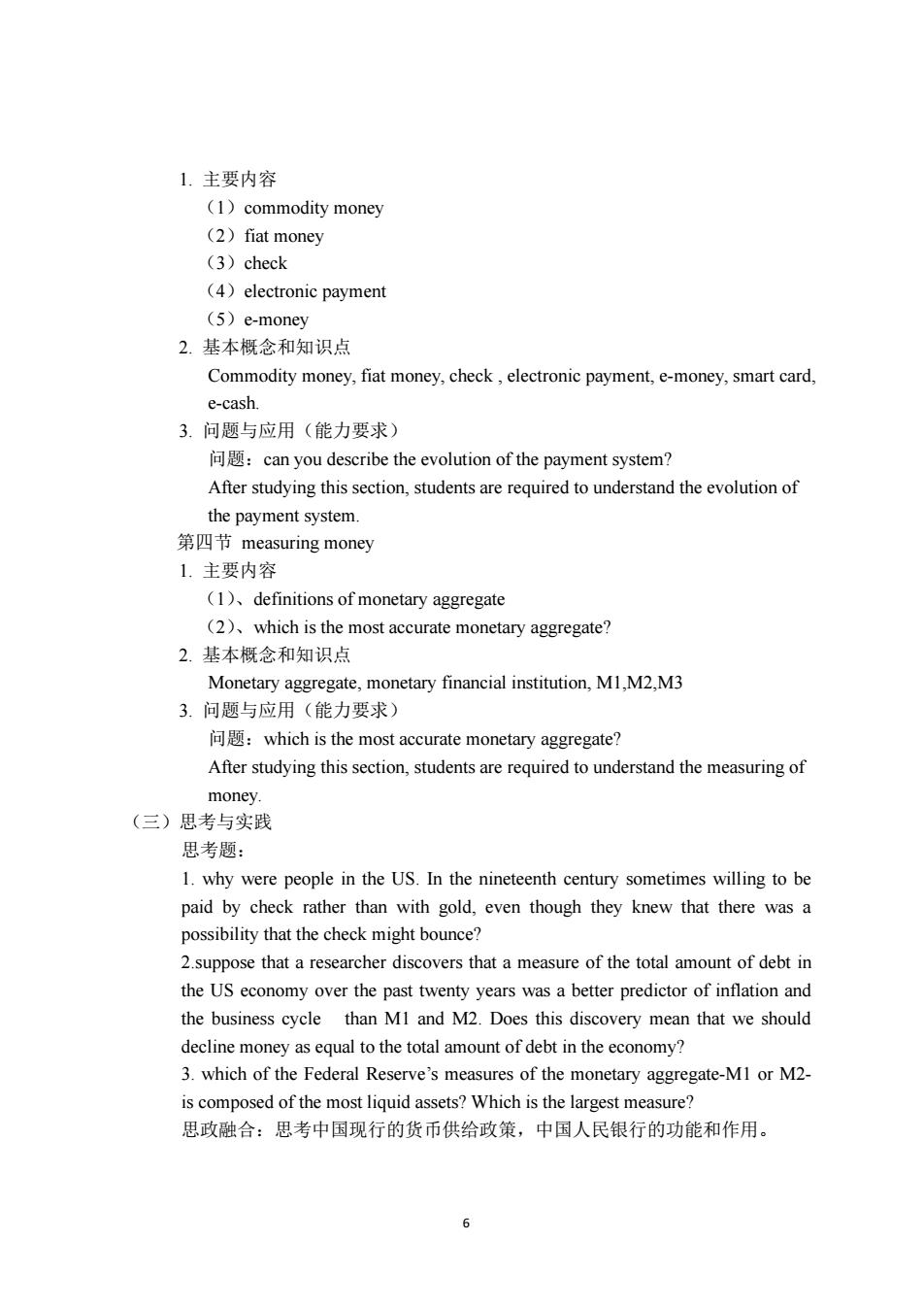
1.主要内容 (1)commodity money (2)fiat money (3)check (4)electronic payment (5)e-money 2.基本概念和知识点 Commodity money,fiat money,check,electronic payment,e-money,smart card, e-cash 3.问题与应用(能力要求) 问题:can you describe the evolution of the payment system? After studying this section,students are required to understand the evolution of the payment system. 第四节measuring money 1.主要内容 (1).definitions of monetary aggregate (2)which is the most accurate monetary aggregate? 2.基本概念和知识点 Monetary aggregate,monetary financial institution,MI,M2,M3 3.问题与应用(能力要求) 问题:which is the most accurate monetary aggregate? After studying this section,students are required to understand the measuring of money (三)思考与实践 思考题: 1.why were people in the US.In the nineteenth century sometimes willing to be paid by check rather than with gold,even though they knew that there was a possibility that the check might bounce? 2.suppose that a researcher discovers that a measure of the total amount of debt in the US economy over the past twenty years was a better predictor of inflation and the business cycle than MI and M2.Does this discovery mean that we should decline money as equal to the total amount of debt in the economy? 3.which of the Federal Reserve's measures of the monetary aggregate-MI or M2- is composed of the most liquid assets?Which is the largest measure? 思政融合:思考中国现行的货币供给政策,中国人民银行的功能和作用。 6
6 1. 主要内容 (1)commodity money (2)fiat money (3)check (4)electronic payment (5)e-money 2. 基本概念和知识点 Commodity money, fiat money, check , electronic payment, e-money, smart card, e-cash. 3. 问题与应用(能力要求) 问题:can you describe the evolution of the payment system? After studying this section, students are required to understand the evolution of the payment system. 第四节 measuring money 1. 主要内容 (1)、definitions of monetary aggregate (2)、which is the most accurate monetary aggregate? 2. 基本概念和知识点 Monetary aggregate, monetary financial institution, M1,M2,M3 3. 问题与应用(能力要求) 问题:which is the most accurate monetary aggregate? After studying this section, students are required to understand the measuring of money. (三)思考与实践 思考题: 1. why were people in the US. In the nineteenth century sometimes willing to be paid by check rather than with gold, even though they knew that there was a possibility that the check might bounce? 2.suppose that a researcher discovers that a measure of the total amount of debt in the US economy over the past twenty years was a better predictor of inflation and the business cycle than M1 and M2. Does this discovery mean that we should decline money as equal to the total amount of debt in the economy? 3. which of the Federal Reserve’s measures of the monetary aggregate-M1 or M2- is composed of the most liquid assets? Which is the largest measure? 思政融合:思考中国现行的货币供给政策,中国人民银行的功能和作用
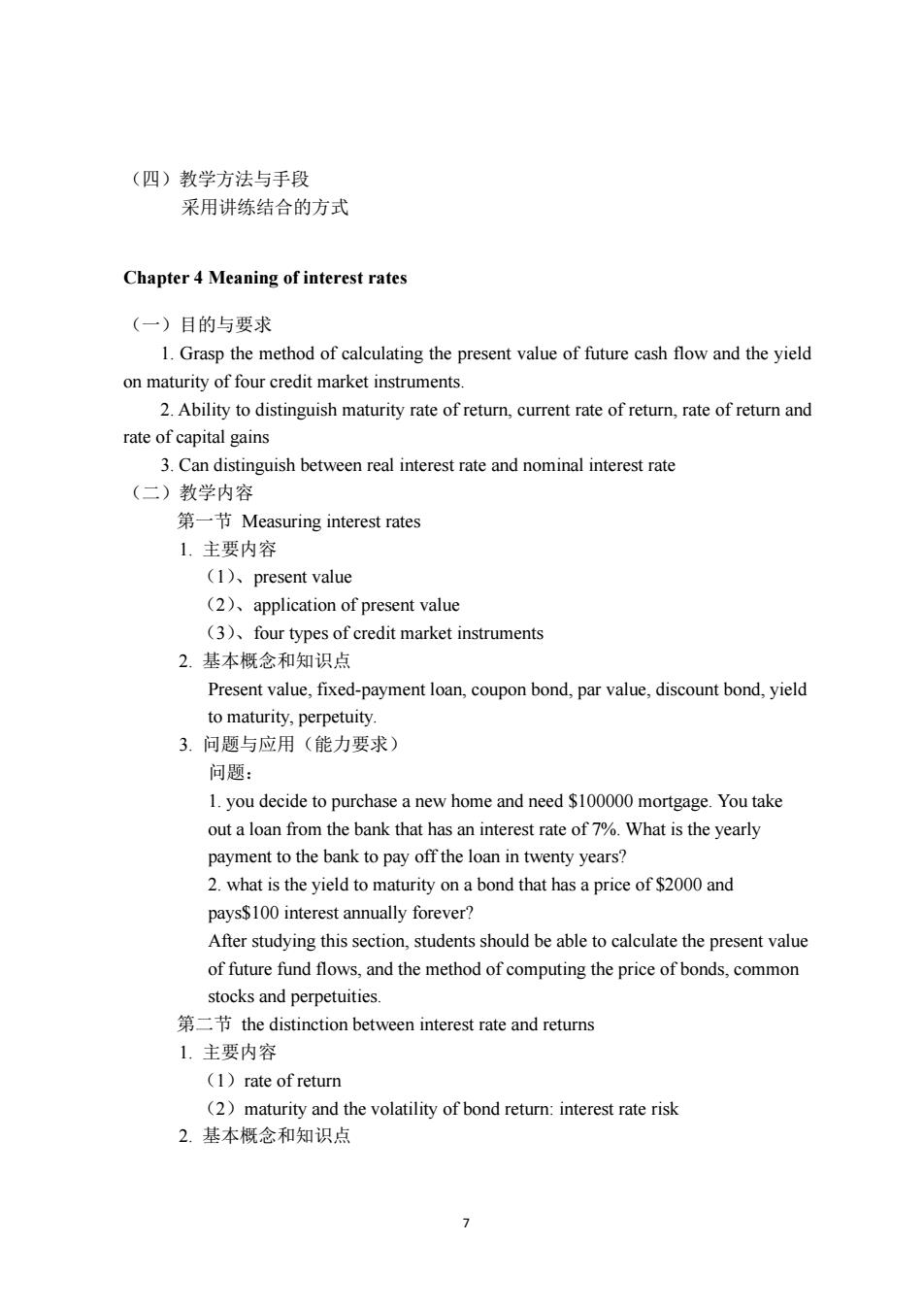
(四)教学方法与手段 采用讲练结合的方式 Chapter 4 Meaning of interest rates (一)目的与要求 1.Grasp the method of calculating the present value of future cash flow and the yield on maturity of four credit market instruments 2.Ability to distinguish maturity rate of return,current rate of return,rate of return and rate of capital gains 3.Can distinguish between real interest rate and nominal interest rate (二)教学内容 第一节Measuring interest rates 1.主要内容 (1)、present value (2)application of present value (3),four types of credit market instruments 2.基本概念和知识点 Present value,fixed-payment loan,coupon bond,par value,discount bond,yield to maturity,perpetuity. 3.问题与应用(能力要求) 问题: 1.you decide to purchase a new home and need $100000 mortgage.You take out a loan from the bank that has an interest rate of 7%.What is the yearly payment to the bank to pay off the loan in twenty years? 2.what is the yield to maturity on a bond that has a price of $2000 and pays$100 interest annually forever? After studying this section,students should be able to calculate the present value of future fund flows,and the method of computing the price of bonds,common stocks and perpetuities 第二节the distinction between interest rate and returns 1.主要内容 (1)rate ofreturn (2)maturity and the volatility of bond return:interest rate risk 2.基本概念和知识点 >
7 (四)教学方法与手段 采用讲练结合的方式 Chapter 4 Meaning of interest rates (一)目的与要求 1. Grasp the method of calculating the present value of future cash flow and the yield on maturity of four credit market instruments. 2. Ability to distinguish maturity rate of return, current rate of return, rate of return and rate of capital gains 3. Can distinguish between real interest rate and nominal interest rate (二)教学内容 第一节 Measuring interest rates 1. 主要内容 (1)、present value (2)、application of present value (3)、four types of credit market instruments 2. 基本概念和知识点 Present value, fixed-payment loan, coupon bond, par value, discount bond, yield to maturity, perpetuity. 3. 问题与应用(能力要求) 问题: 1. you decide to purchase a new home and need $100000 mortgage. You take out a loan from the bank that has an interest rate of 7%. What is the yearly payment to the bank to pay off the loan in twenty years? 2. what is the yield to maturity on a bond that has a price of $2000 and pays$100 interest annually forever? After studying this section, students should be able to calculate the present value of future fund flows, and the method of computing the price of bonds, common stocks and perpetuities. 第二节 the distinction between interest rate and returns 1. 主要内容 (1)rate of return (2)maturity and the volatility of bond return: interest rate risk 2. 基本概念和知识点
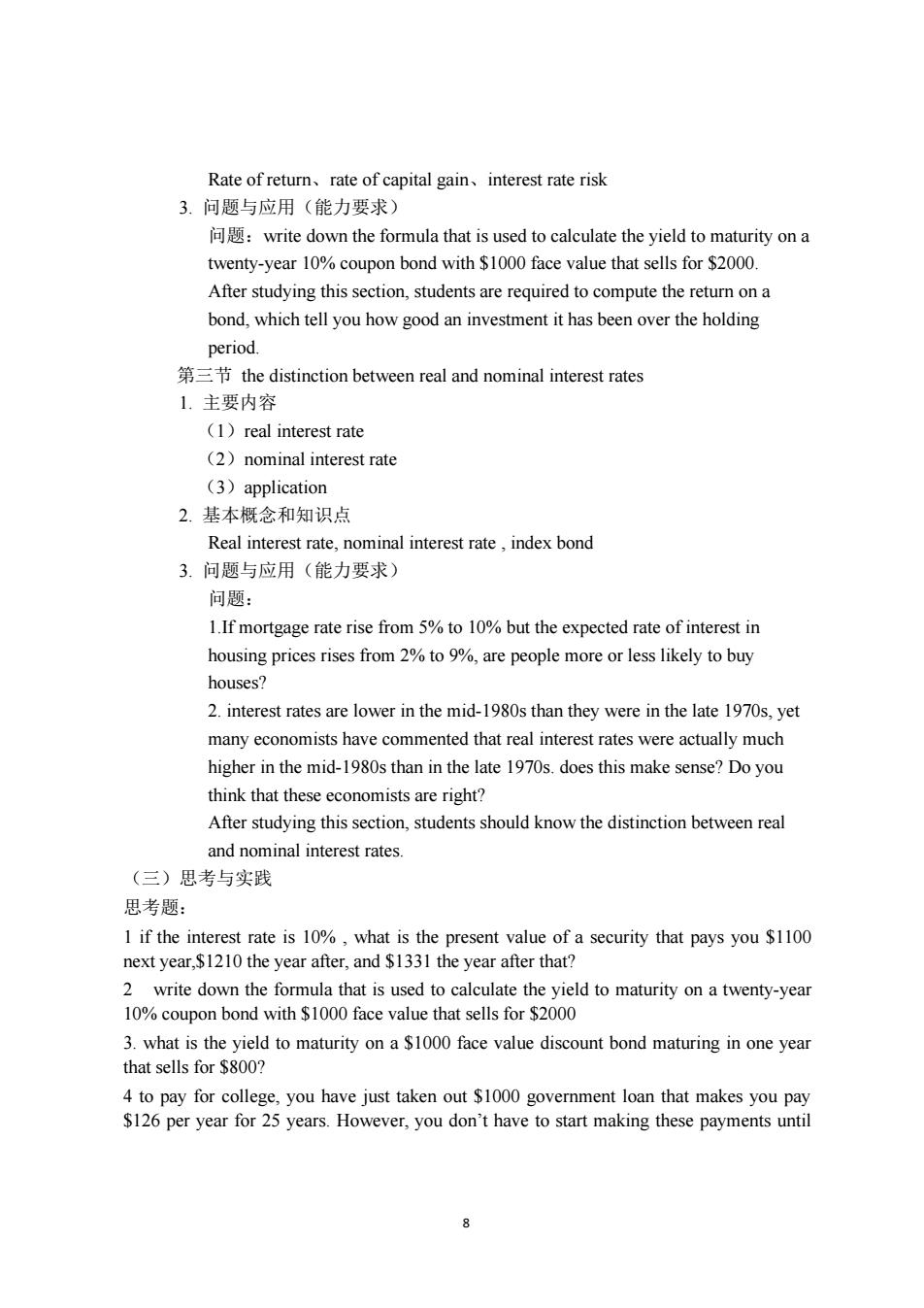
Rate of return,rate of capital gain,interest rate risk 3.问题与应用(能力要求) write down the formula that is used to calculate the yield to maturity on a twenty-year 10%coupon bond with $1000 face value that sells for $2000 After studying this section,students are required to compute the return on a bond,which tell you how good an investment it has been over the holding period 第三节the distinction between real and nominal interest rates 1.主要内容 (1)real interest rate (2)nominal interest rate (3)application 2.基本概念和知识点 Real interest rate,nominal interest rate.index bond 3.问题与应用(能力要求) 问题: 1.If mortgage rate rise from%to1%but the expected rate of interest in housing prices rises from 2%to 9%,are people more or less likely to buy houses? 2.interest rates are lower in the mid-1980s than they were in the late 1970s,yet many economists have commented that real interest rates were actually much higher in the mid-1980s than in the late 1970s.does this make sense?Do you think that these economists are right? After studying this section,students should know the distinction between real and nominal interest rates (三)思考与实践 思考题: 1 if the interest rate is%what is the present value of a security that pays you$1100 next year,$1210 the year after,and $1331 the year after that? 2 write down the formula that is used to calculate the yield to maturity on a twenty-year 10%coupon bond with $1000 face value that sells for $2000 3.what is the yield to maturity on a $1000 face value discount bond maturing in one year that sells for $800? 4 to pay for college,you have just taken out $1000 government loan that makes you pay $126 per year for 25 years.However,you don't have to start making these payments until 8
8 Rate of return、rate of capital gain、interest rate risk 3. 问题与应用(能力要求) 问题:write down the formula that is used to calculate the yield to maturity on a twenty-year 10% coupon bond with $1000 face value that sells for $2000. After studying this section, students are required to compute the return on a bond, which tell you how good an investment it has been over the holding period. 第三节 the distinction between real and nominal interest rates 1. 主要内容 (1)real interest rate (2)nominal interest rate (3)application 2. 基本概念和知识点 Real interest rate, nominal interest rate , index bond 3. 问题与应用(能力要求) 问题: 1.If mortgage rate rise from 5% to 10% but the expected rate of interest in housing prices rises from 2% to 9%, are people more or less likely to buy houses? 2. interest rates are lower in the mid-1980s than they were in the late 1970s, yet many economists have commented that real interest rates were actually much higher in the mid-1980s than in the late 1970s. does this make sense? Do you think that these economists are right? After studying this section, students should know the distinction between real and nominal interest rates. (三)思考与实践 思考题: 1 if the interest rate is 10% , what is the present value of a security that pays you $1100 next year,$1210 the year after, and $1331 the year after that? 2 write down the formula that is used to calculate the yield to maturity on a twenty-year 10% coupon bond with $1000 face value that sells for $2000 3. what is the yield to maturity on a $1000 face value discount bond maturing in one year that sells for $800? 4 to pay for college, you have just taken out $1000 government loan that makes you pay $126 per year for 25 years. However, you don’t have to start making these payments until
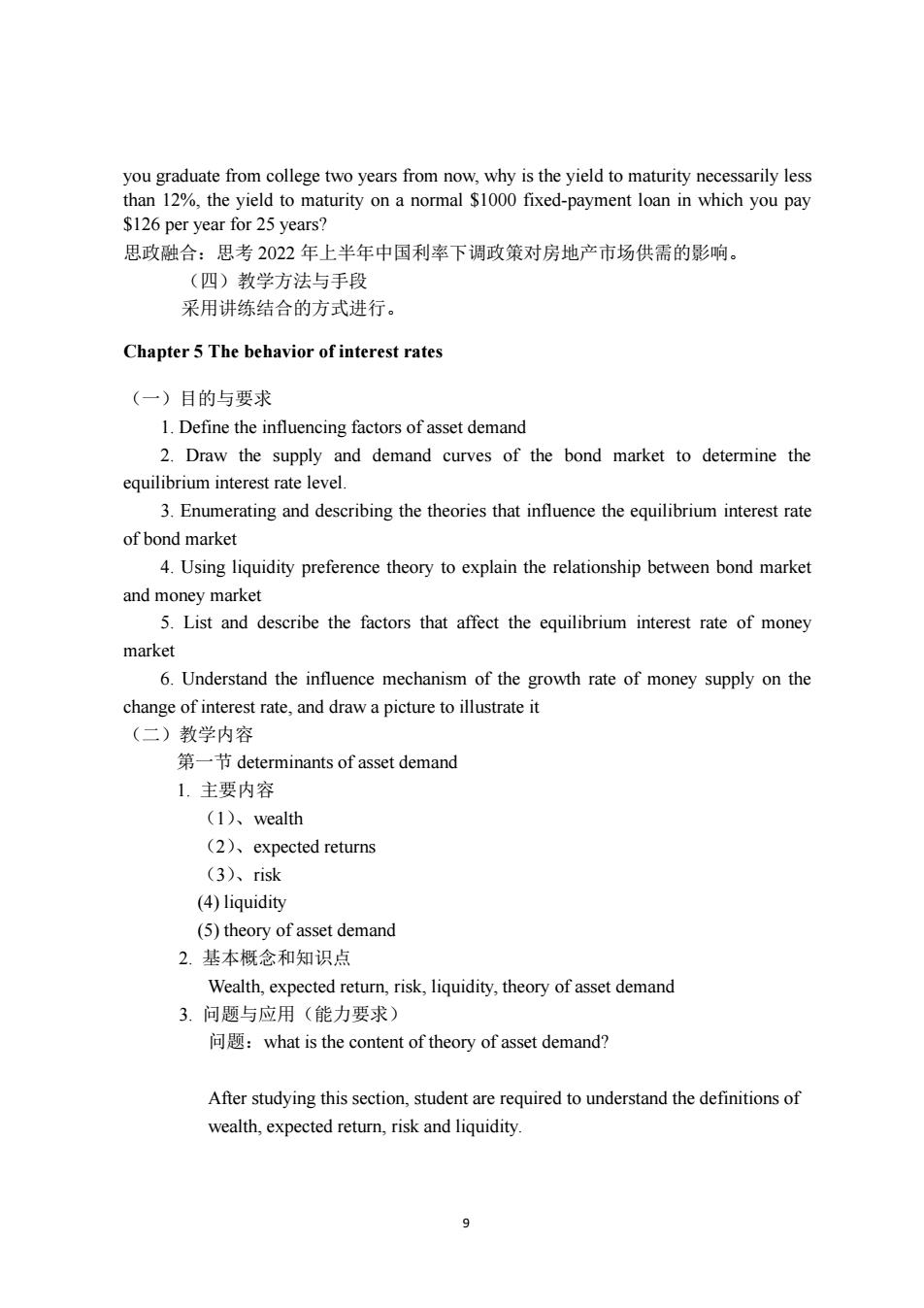
you graduate from college two years from now,why is the yield to maturity necessarily less than 12%,the yield to maturity on a normal $1000 fixed-payment loan in which you pay $126 per vear for 25 vears? 思政融合:思考2022年上半年中国利率下调政策对房地产市场供需的影响。 (四)教学方法与手段 采用讲练结合的方式进行。 Chapter 5 The behavior of interest rates (一)目的与要求 1.Define the influencing factors of asset demand 2.Draw the supply and demand curves of the bond market to determine the equilibrium interest rate level. 3.Enumerating and describing the theories that influence the equilibrium interest rate of bond market 4.Using liquidity preference theory to explain the relationship between bond market and money market 5.List and describe the factors that affect the equilibrium interest rate of money market 6.Understand the influence mechanism of the growth rate of money supply on the change of interest rate,and draw a picture to illustrate it (二)教学内容 第-节determinants ofasset demand 1.主要内容 (1)、wealth (2)、expected returns (3)、risk (4)liquidity (5)theory of asset demand 2.基本概念和知识点 Wealth,expected return,risk,liquidity,theory of asset demand 3.问题与应用(能力要求) 问题:what is the content of theory of asset demand? After studying this section,student are required to understand the definitions of wealth,expected retur,risk and liquidity 9
9 you graduate from college two years from now, why is the yield to maturity necessarily less than 12%, the yield to maturity on a normal $1000 fixed-payment loan in which you pay $126 per year for 25 years? 思政融合:思考 2022 年上半年中国利率下调政策对房地产市场供需的影响。 (四)教学方法与手段 采用讲练结合的方式进行。 Chapter 5 The behavior of interest rates (一)目的与要求 1. Define the influencing factors of asset demand 2. Draw the supply and demand curves of the bond market to determine the equilibrium interest rate level. 3. Enumerating and describing the theories that influence the equilibrium interest rate of bond market 4. Using liquidity preference theory to explain the relationship between bond market and money market 5. List and describe the factors that affect the equilibrium interest rate of money market 6. Understand the influence mechanism of the growth rate of money supply on the change of interest rate, and draw a picture to illustrate it (二)教学内容 第一节 determinants of asset demand 1. 主要内容 (1)、wealth (2)、expected returns (3)、risk (4) liquidity (5) theory of asset demand 2. 基本概念和知识点 Wealth, expected return, risk, liquidity, theory of asset demand 3. 问题与应用(能力要求) 问题:what is the content of theory of asset demand? After studying this section, student are required to understand the definitions of wealth, expected return, risk and liquidity
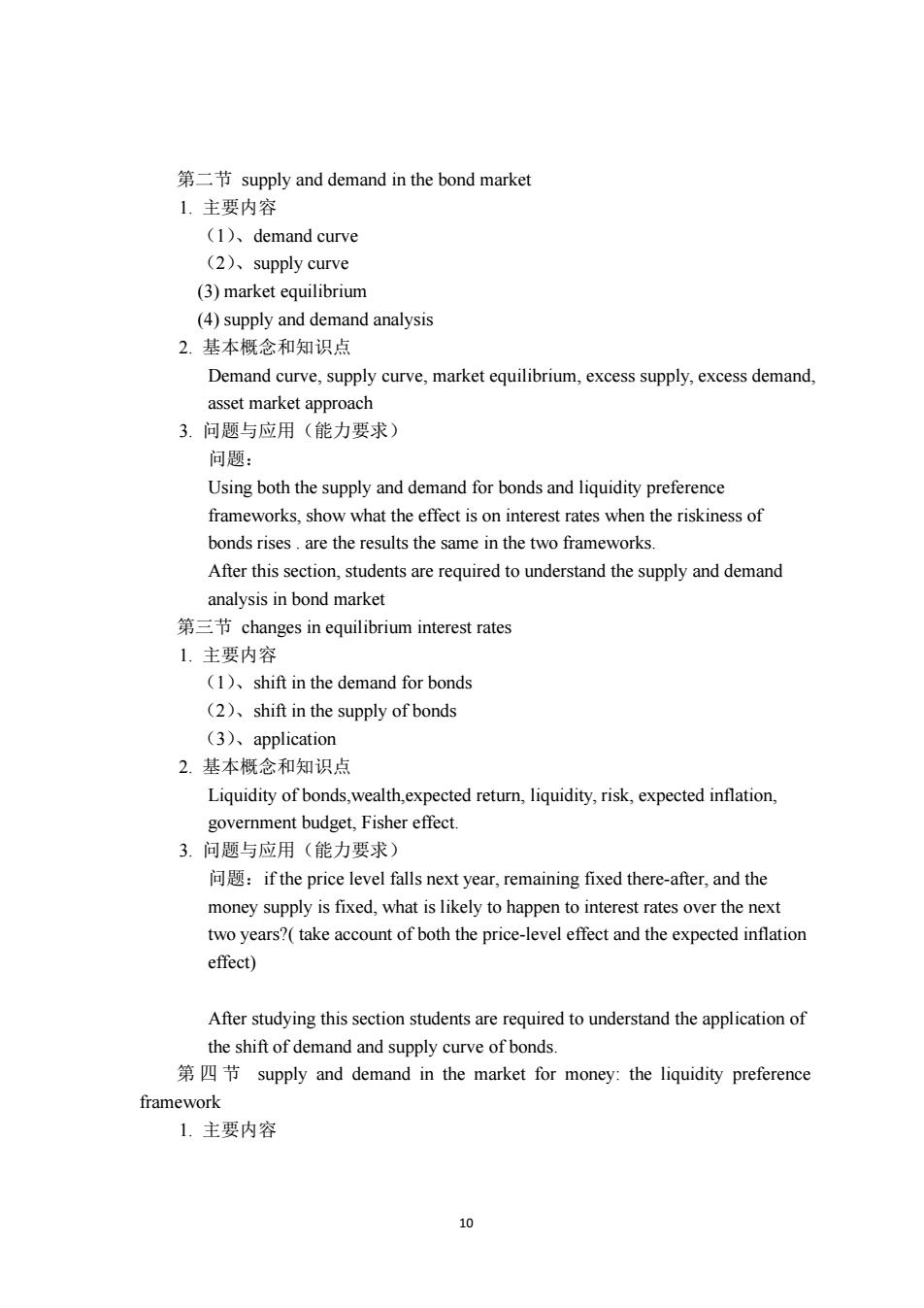
第二节supply and demand in the bond market 1.主要内容 (1)、demand curve (2)、supply curve (3)market equilibrium (4)supply and demand analysis 2.基本概念和知识点 Demand curve,supply curve,market equilibrium,excess supply,excess demand, asset market approach 3.问题与应用(能力要求) 问题: Using both the supply and demand for bonds and liquidity preference frameworks,show what the effect is on interest rates when the riskiness of bonds rises.are the results the same in the two frameworks. After this section,students are required to understand the supply and demand analysis in bond market 第三节changes in equilibrium interest rates 1.主要内容 (1),shift in the demand for bonds (2),shift in the supply of bonds (3)、application 2.基本概念和知识点 Liquidity of bonds,wealth,expected return,liquidity,risk,expected inflation government budget,Fisher effect. 3.问题与应用(能力要求) if the price level falls next year,remaining fixed there-after,and the money supply is fixed,what is likely to happen to interest rates over the next two years?(take account of both the price-level effect and the expected inflation effect) After studying this section students are required to understand the application of the shift of demand and supply curve of bonds. 第四节supply and demand in the market for money:the liquidity preference framework 1.主要内容 10
10 第二节 supply and demand in the bond market 1. 主要内容 (1)、demand curve (2)、supply curve (3) market equilibrium (4) supply and demand analysis 2. 基本概念和知识点 Demand curve, supply curve, market equilibrium, excess supply, excess demand, asset market approach 3. 问题与应用(能力要求) 问题: Using both the supply and demand for bonds and liquidity preference frameworks, show what the effect is on interest rates when the riskiness of bonds rises . are the results the same in the two frameworks. After this section, students are required to understand the supply and demand analysis in bond market 第三节 changes in equilibrium interest rates 1. 主要内容 (1)、shift in the demand for bonds (2)、shift in the supply of bonds (3)、application 2. 基本概念和知识点 Liquidity of bonds,wealth,expected return, liquidity, risk, expected inflation, government budget, Fisher effect. 3. 问题与应用(能力要求) 问题:if the price level falls next year, remaining fixed there-after, and the money supply is fixed, what is likely to happen to interest rates over the next two years?( take account of both the price-level effect and the expected inflation effect) After studying this section students are required to understand the application of the shift of demand and supply curve of bonds. 第 四 节 supply and demand in the market for money: the liquidity preference framework 1. 主要内容